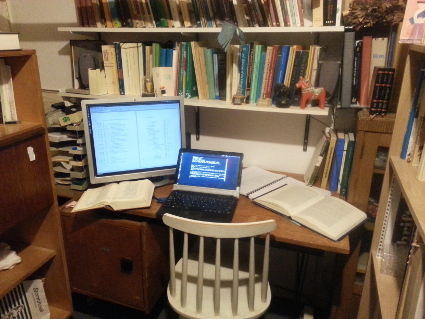By Hendrik Jan Bosman
On May 29, I hope to defend my dissertation, Prosodic Influence on the Text Syntax of Lamentations (DOI: https://doi.org/10.5281/zenodo.2613385). The book has a linguistic focus, and is rooted in the ETCBC procedures and programs.
Yet, I will defend it before the Faculty of Religion and Theology. This is no accident or historical coincidence. From the get go, Eep Talstra, the founder of the ETCBC, has viewed his work as essentially part of a theological endeavour. Clarifying the communicational processes in the texts, as coded by their linguistic signals, provides us with a means to enter into that communication ourselves. For poetic texts, I propose that not only the textsyntactic signals need to be studied, but also the prosodic structure (cola, verses and strophes) and, more specifically, the interaction between the two. A poem is not a newspaper article or judiciary report, and its form creates a quite specific mode of communication.
Ideally, each structure should first be studied separately. However, in my work on Lamentations I found that this is not always possible. Syntax and prosody can influence each other in non-trivial ways. It is here that my actual research sets in. I investigate the problem on the textsyntactic side, and find many instances in the book of Lamentations where prosodic structure has led to a textsyntactic analysis different from what a strictly syntactic analysis would suggest.
Especially the rhythm of parallel verselines and regular strophes can have its effect on the grouping and hierarchy of clauses. The acrostics in Lam 1-4 (especially in vav strophes) form another clear influence. The conclusion is clear: In text syntactic analysis of poetic texts, some prosodic phenomena must be taken into account. For this, I make some practical recommendations. Some of these I have implemented some of these in Python text description programs, based on the Emdros database system and the ETCBC data on Lamentations (www.github.com/HendrikJanBosman/emdrosapp_src).
In a final chapter, I venture from text syntax to exegesis, by sketching the interaction between syntax and prosodic form in Lam 3 and 5. Lam 3 starts with a long series of descriptive qatal clauses. By breaking them up into three-line strophes, the poet prevents the reader from trailing off, and presents every strophe as a new picture, which requires attention. In Lam 3, text syntax chains the stanzas into a discourse, each one being a textsyntactic introduction to the next. In them, the speaker calls his audience to regain hope and pray. When they do start praying, but get bogged down in laments, the speaker interrupts, in the middle of a strophe!, and finishes the prayer for them. In Lam 5, a prayer in we-form, the people
finally follow the example:
‘Return us to you, Yhwh, and we will return.’
Which, in turn, works as an invitation to us, the readers, to do the same.
This excursus does not imply that I see exegesis as the ultimate goal and syntactic research as its auxiliary. Text syntax and prosodic form are fascinating and important fields of research of their own, and I hope to study them much more. I am grateful, though, that for my dissertation I was able to combine my fascination for such diverse subjects as prosodic form, Biblical Hebrew, exegesis and computing into a single project.
The defense will be on May 29, at 15:45h, in the Aula of the Vrije University.


